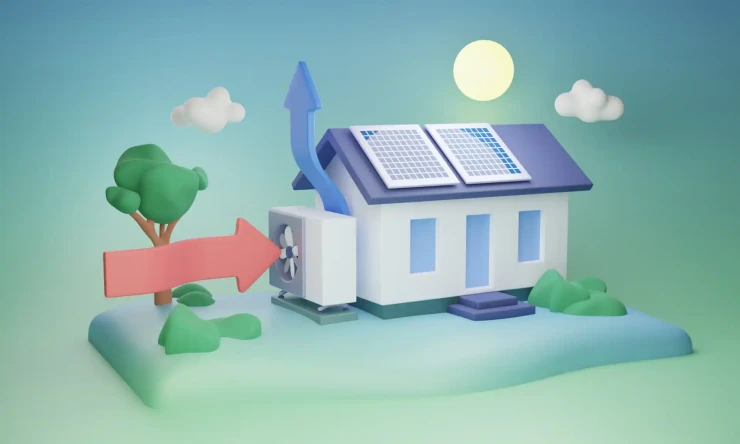Even before Russia’s invasion of Ukraine a serious energy crisis was looming in the UK. The need to speed up the roll-out of home-grown energy has become even more urgent now. With the price of energy reaching record highs in the UK, the potential of domestic solar power has gained particular interest over the past year.
The energy cap rose to £2,500 in October 2022 and will increase again in April 2023 which means that homeowners’ energy bills will rise yet again. More people than ever are being attracted to using the sun’s energy as a money-saving tool. Britons are hunting for ways to cut their huge energy bills and are realising that as the energy cap rises, solar panels are paying for themselves in record quick time. When the price of energy was lower, it could take up to 15 years to break even but now according to a report in the Guardian the payback period can be as little as seven years or even possibly five years.
COMPARE PRICES FROM LOCAL INSTALLERS
Compare prices from local companies fast & free
Enter your postcode to compare quotes from leading professionals. We promise to keep your information Safe & Secure. Privacy Policy
The boom in an industry known for its unpredictable fortunes has been referred to as the “Solar Coaster”. Solar installers are reporting unusually high interest from homeowners looking to generate, use and sell electricity on their roofs, with many struggling to meet the demand they are seeing. Some suppliers have seen a 400-500% increase in orders!
The amount of money you can save by installing solar panels will depend on a number of factors including:
- Your home’s electricity consumption
- The size of your solar panel system
- The type of solar panels
- The angle of your roof
- How much is paid to you through Smart Export Guarantee Schemes
- The location of your home.
Legislation for the Smart Export Guarantee Scheme came into effect in 2020. Suppliers with more than 150,000 customers were required to launch an export tariff. Designed to support a competitive export market the scheme both encouraged households to choose to install renewable energy to reduce their bills and helped to provide additional sources of clean energy to the grid. There are 13 suppliers that currently offer SEG tariffs, with the highest tariff available from Octopus Energy at 15p/kWh for its Fixed Outgoing tariff.
One of the most asked questions when a homeowner is considering installing solar panels is about the payback period. If they invest money in a solar panel system, when will they break even? At the moment the time it takes to break even on the investment is decreasing.
The time it takes to break even on solar panels will depend on the following factors:
- Your energy consumption
- Initial cost of your solar panel system
- Price of electricity
- If you have a solar battery
- If you’re part of the SEG scheme
- Where you live
To demonstrate what the payback period of a typical solar installation would be, here is an example of an asset modelled for Solar Power Portal by Gridcog. Here is a breakdown of the details:
Gridcog modelled a 4KWp installation, oriented 180º south, tilted 30º, over a ten-year period from 1 January 2023.
The capital expenditure for an installation like this would be around £5,000. The Energy Saving Trust suggests that residential installations generally cost between £3,500 and £7,300.
Gridcog applied a derating factor of 89% to the installation, along with an assumption of 0.4% degradation per year.
At the present time the unit price for electricity under a standard variable tariff is set at around 34.0kWh inclusive of VAT under the Energy Price Guarantee, and the standing charge is around 46.36p/day.
For the purposes of its model, Gricog looked at using the Octopus Fixed Outgoing tariff which is currently 15p/kWh.
It’s important to note that for a real-world installation you would expect the SEG tariff to change over a 10-year period. For example, the Octopus tariff doubled from its previous rate of 7.5p/kWh to 15p/kWh in September 2022.
Gridcog used a household with an annual consumption of 3MWh for its model, just above Ofgem’s estimate for the average household in Britain at 2,900kWh of electricity per year.
Within the baseline scenario, Gridcog found that the household’s electricity spend in total was £1,190/year (£1,020 energy, £170 standing charge).
If the household uses a little under 1MWh from its solar installation, the cost of imported electricity is reduced to £865/year (£695 energy, £170 standing charge). The SEG tariff would earn -£400/year for the household under the assumption that 2.7MWh of electricity was exported to the grid.
This means that the total energy spend for the household is therefore £465/year, a saving of £725/year.
Using this model and ignoring the cost of capital/interest at this point, the payback period for this installation would end in September 2029 and be 6.75 years.
Over the decade that this example was modelled on, the return on investment would be £2,280 or 46%.
Of course, every property is different, and every household has differing energy needs but it is estimated that the average household could save up to £1,000 a year on their energy bills by producing their own electricity through solar panels. As shown in the example above this includes direct savings by not using power from the National Grid as well as income from selling any excess power back to the grid through the SEG. The Energy Saving Trust has developed a calculator to help households determine roughly how much they can save on their bills by switching to solar power.
Gridcog’s analysis fits in with analysis from the Energy and Climate Intelligence Unit which found that the payback time of rooftop solar panels is now just six years, meaning the average installation will provide effectively free power for 19 years.
The addition of battery energy storage will further boost the payback period of an installation by providing further flexibility to the asset.
Gridcog noted:
“If a battery storage system is added, the load can be shifted so more of the solar output is self-consumed. Whether this makes sense economically depends on the battery size/cost, load pattern, and the price differential between the energy import and export. The case for the battery improves if the household has sharper price signals, e.g., a time-of-use tariff or energy prices that track the wholesale prices more closely.”
Whilst energy prices remain high if you combine solar PV with a battery energy storage system you could see savings of around £40,000 over the system’s lifetime for a standard mid-terrace house.





























